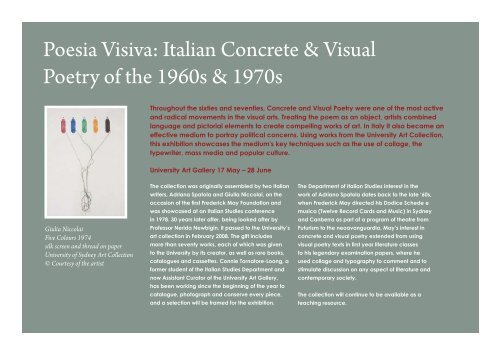Language and Culture issue 8 march 09 - The University of Sydney
Language and Culture issue 8 march 09 - The University of Sydney
Language and Culture issue 8 march 09 - The University of Sydney
Create successful ePaper yourself
Turn your PDF publications into a flip-book with our unique Google optimized e-Paper software.
Poesia Visiva: Italian Concrete & Visual<br />
Poetry <strong>of</strong> the 1960s & 1970s<br />
Giulia Niccolai<br />
Five Colours 1974<br />
silk screen <strong>and</strong> thread on paper<br />
<strong>University</strong> <strong>of</strong> <strong>Sydney</strong> Art Collection<br />
© Courtesy <strong>of</strong> the artist<br />
Throughout the sixties <strong>and</strong> seventies, Concrete <strong>and</strong> Visual Poetry were one <strong>of</strong> the most active<br />
<strong>and</strong> radical movements in the visual arts. Treating the poem as an object, artists combined<br />
language <strong>and</strong> pictorial elements to create compelling works <strong>of</strong> art. In Italy it also became an<br />
effective medium to portray political concerns. Using works from the <strong>University</strong> Art Collection,<br />
this exhibition showcases the medium's key techniques such as the use <strong>of</strong> collage, the<br />
typewriter, mass media <strong>and</strong> popular culture.<br />
<strong>University</strong> Art Gallery 17 May – 28 June<br />
<strong>The</strong> collection was originally assembled by two Italian<br />
writers, Adriana Spatola <strong>and</strong> Giulia Niccolai, on the<br />
occasion <strong>of</strong> the first Frederick May Foundation <strong>and</strong><br />
was showcased at an Italian Studies conference<br />
in 1978. 30 years later after, being looked after by<br />
Pr<strong>of</strong>essor Nerida Newbigin, it passed to the <strong>University</strong>’s<br />
art collection in February 2008. <strong>The</strong> gift includes<br />
more than seventy works, each <strong>of</strong> which was given<br />
to the <strong>University</strong> by its creator, as well as rare books,<br />
catalogues <strong>and</strong> cassettes. Connie Tornatore-Loong, a<br />
former student <strong>of</strong> the Italian Studies Department <strong>and</strong><br />
now Assistant Curator <strong>of</strong> the <strong>University</strong> Art Gallery,<br />
has been working since the beginning <strong>of</strong> the year to<br />
catalogue, photograph <strong>and</strong> conserve every piece,<br />
<strong>and</strong> a selection will be framed for the exhibition.<br />
<strong>The</strong> Department <strong>of</strong> Italian Studies interest in the<br />
work <strong>of</strong> Adriano Spatola dates back to the late ‘60s,<br />
when Frederick May directed his Dodice Schede e<br />
musica (Twelve Record Cards <strong>and</strong> Music) in <strong>Sydney</strong><br />
<strong>and</strong> Canberra as part <strong>of</strong> a program <strong>of</strong> theatre from<br />
Futurism to the neoavanguardia. May’s interest in<br />
concrete <strong>and</strong> visual poetry extended from using<br />
visual poetry texts in first year literature classes<br />
to his legendary examination papers, where he<br />
used collage <strong>and</strong> typography to comment <strong>and</strong> to<br />
stimulate discussion on any aspect <strong>of</strong> literature <strong>and</strong><br />
contemporary society.<br />
<strong>The</strong> collection will continue to be available as a<br />
teaching resource.

















